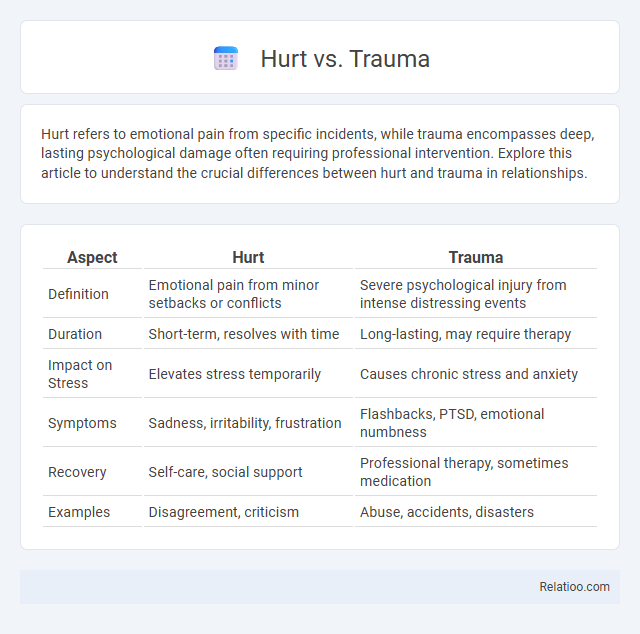Hurt refers to emotional pain from specific incidents, while trauma encompasses deep, lasting psychological damage often requiring professional intervention. Explore this article to understand the crucial differences between hurt and trauma in relationships.
Table of Comparison
| Aspect | Hurt | Trauma |
|---|---|---|
| Definition | Emotional pain from minor setbacks or conflicts | Severe psychological injury from intense distressing events |
| Duration | Short-term, resolves with time | Long-lasting, may require therapy |
| Impact on Stress | Elevates stress temporarily | Causes chronic stress and anxiety |
| Symptoms | Sadness, irritability, frustration | Flashbacks, PTSD, emotional numbness |
| Recovery | Self-care, social support | Professional therapy, sometimes medication |
| Examples | Disagreement, criticism | Abuse, accidents, disasters |
Understanding Hurt vs Trauma
Hurt refers to emotional pain resulting from specific events, often transient and linked to personal interactions, while trauma involves deep psychological damage caused by prolonged or intense stress, which can lead to lasting mental health issues such as PTSD. Understanding hurt requires recognizing immediate feelings of sadness or disappointment, whereas trauma necessitates acknowledging complex symptoms like flashbacks, anxiety, and emotional numbness. Differentiating between the two helps in providing appropriate support, with hurt often addressed through empathy and communication, and trauma requiring professional intervention and therapeutic strategies.
Defining Hurt: Everyday Emotional Pain
Hurt refers to everyday emotional pain caused by minor slights, misunderstandings, or disappointments that impact your feelings momentarily. This type of pain often involves feelings of sadness, frustration, or irritation but usually subsides with time and communication. Understanding hurt helps differentiate it from deeper trauma or ongoing emotional suffering.
What Constitutes Trauma?
Trauma constitutes a profound emotional response resulting from an overwhelming event that threatens your safety or well-being, often leaving lasting psychological effects unlike ordinary hurt or pain. While hurt refers to temporary emotional or physical discomfort, trauma deeply impacts mental health, potentially causing conditions such as PTSD or anxiety disorders. Understanding trauma involves recognizing its capacity to alter brain function and behavior, highlighting the need for appropriate therapeutic interventions.
Key Differences Between Hurt and Trauma
Hurt typically refers to emotional pain caused by specific events or actions, while trauma involves a deeper, often long-lasting psychological impact resulting from severe or repeated distressing experiences. Trauma can disrupt your mental health and everyday functioning more significantly than simple hurt, which is usually temporary and less complex. Understanding these key differences helps in addressing your emotional needs effectively.
Causes and Triggers of Hurt
Hurt arises from emotional pain caused by specific actions or words that wound your feelings, often triggered by perceived rejection or criticism. Trauma results from overwhelming experiences such as abuse, accidents, or natural disasters that disrupt your psychological well-being and can cause long-lasting damage. Understanding the distinct causes and triggers of hurt versus trauma helps identify appropriate coping mechanisms for emotional recovery.
Sources and Types of Trauma
Sources of trauma include physical abuse, emotional neglect, and witnessing violence, all of which result in psychological distress rather than just momentary hurt. Trauma types vary from acute, caused by a single event like an accident, to complex, stemming from prolonged exposure to harmful experiences such as ongoing domestic abuse. Unlike temporary hurt, trauma often leads to long-lasting emotional and cognitive effects that require therapeutic intervention.
Emotional Impact: Hurt vs Trauma
Emotional impact from hurt often involves temporary pain or distress triggered by specific incidents such as criticism or rejection, causing feelings like sadness or frustration. Trauma results in deeper, long-lasting emotional wounds that may disrupt normal functioning and manifest as anxiety, depression, or PTSD due to overwhelming experiences like abuse or accidents. Understanding the distinction aids in addressing immediate emotional hurt with support while recognizing trauma requires comprehensive therapeutic intervention for healing.
Signs and Symptoms to Recognize
Hurt often presents as emotional pain with symptoms like sadness or irritability, while trauma can cause more intense signs such as flashbacks, anxiety, and hypervigilance. Recognizing these differences is crucial for your mental health since trauma symptoms may include dissociation and difficulty trusting others, whereas hurt might resolve with time and support. Understanding these distinctions helps identify when professional intervention is necessary.
Healing and Coping Strategies
Healing from hurt, trauma, and emotional pain requires distinct coping strategies tailored to the severity and nature of each experience. Hurt often involves temporary emotional distress that you can manage through self-care techniques like mindfulness and open communication, while trauma demands professional support such as therapy or trauma-informed counseling to process deep psychological wounds. Prioritizing your mental health by recognizing the unique challenges of hurt and trauma enables more effective healing and long-term resilience.
When to Seek Professional Help
Seek professional help if emotional hurt persists beyond a few weeks, significantly disrupts daily functioning, or escalates toward trauma symptoms such as flashbacks, intense anxiety, or emotional numbness. Trauma often requires specialized treatment from therapists trained in trauma-focused approaches like EMDR or CBT, especially when symptoms impair personal or professional life. Early intervention by mental health professionals improves outcomes and prevents the intensification of psychological distress.

Infographic: Hurt vs Trauma
 relatioo.com
relatioo.com